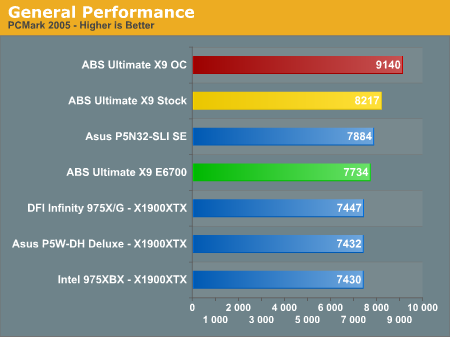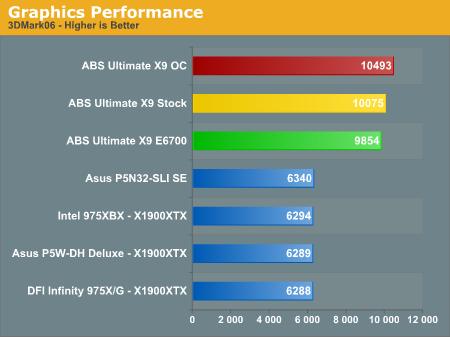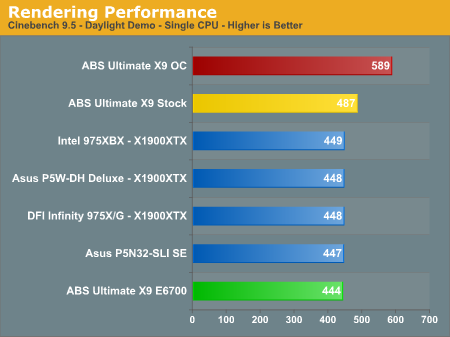ABS Ultimate X9: Core 2 Extreme Hits a Speed Bump
by Jarred Walton on August 18, 2006 1:35 PM EST- Posted in
- Systems
Standard Application Benchmarks
We'll begin with a look at typical application performance. Results from PCMark05, 3DMark06, and Cinebench 9.5 were collected. As mentioned already, the higher clock speed of the ABS system should result in higher performance, particularly in situations where we are CPU limited. Those of you wondering how a 3.5 GHz Core 2 processor performs need look no further.




The results in 3DMark06 aren't particularly meaningful, as none of the other systems were tested with a CrossFire setup. Given that we consider 3DMark to be a synthetic GPU performance test, we're not too concerned with the numbers anyway. One thing that you can see with 3DMark06 is that we are almost completely GPU limited, gaining only 6% more performance with a 32 %CPU clock speed increase. We will see if that same pattern holds true for actual games on the coming pages.
Performance results in PCMark05 are also slightly skewed by the CrossFire graphics configuration, not to mention the use of two Raptor drives in RAID 0. However, we feel these results are more real world, and the simple fact of the matter is that faster hard drives, GPUs, and processors can certainly improve the overall system performance to the point where it is noticeable by the end user. Increases in CPU speed come with a roughly 2-to-1 improvement in PCMark05 scores. The 20% OC is 11% faster than the stock X6800, and the X6800 is 6% faster than the E6700 while being clocked 10% higher.
Closing up with Cinebench 9.5, we have an application that scales almost linearly with CPU clock speed. If your typical usage scenario consists of a lot of video encoding or 3D rendering, faster processors are extremely helpful, and that's what we see here. Cinebench also shows the advantage of multicore systems, improving rendering performance by over 85% when moving from a single core to dual cores. Unfortunately, not all commonly used tasks benefit that much from multiple processor cores, but heavy multitasking will certainly be faster.
We already knew that the Core 2 Extreme was fast, and overclocking it just makes it that much faster. Many commonly used tasks will benefit, particularly CPU-intensive tasks. Games are often considered CPU-intensive in nature, of course, so let's see what happens when we put the X1900 cards to good use.
We'll begin with a look at typical application performance. Results from PCMark05, 3DMark06, and Cinebench 9.5 were collected. As mentioned already, the higher clock speed of the ABS system should result in higher performance, particularly in situations where we are CPU limited. Those of you wondering how a 3.5 GHz Core 2 processor performs need look no further.




Performance results in PCMark05 are also slightly skewed by the CrossFire graphics configuration, not to mention the use of two Raptor drives in RAID 0. However, we feel these results are more real world, and the simple fact of the matter is that faster hard drives, GPUs, and processors can certainly improve the overall system performance to the point where it is noticeable by the end user. Increases in CPU speed come with a roughly 2-to-1 improvement in PCMark05 scores. The 20% OC is 11% faster than the stock X6800, and the X6800 is 6% faster than the E6700 while being clocked 10% higher.
Closing up with Cinebench 9.5, we have an application that scales almost linearly with CPU clock speed. If your typical usage scenario consists of a lot of video encoding or 3D rendering, faster processors are extremely helpful, and that's what we see here. Cinebench also shows the advantage of multicore systems, improving rendering performance by over 85% when moving from a single core to dual cores. Unfortunately, not all commonly used tasks benefit that much from multiple processor cores, but heavy multitasking will certainly be faster.
We already knew that the Core 2 Extreme was fast, and overclocking it just makes it that much faster. Many commonly used tasks will benefit, particularly CPU-intensive tasks. Games are often considered CPU-intensive in nature, of course, so let's see what happens when we put the X1900 cards to good use.










48 Comments
View All Comments
yyrkoon - Tuesday, August 22, 2006 - link
Ah, I was wondering why you were mentioning .NET in technologies you were unhappy with. .NET is really a boon for programmers, and even more so for hobbyist programmers such as myself (it makes things much easier, and faster to code very usefull applications ).JarredWalton - Monday, August 21, 2006 - link
Of course, after looking at some of the results on the AM2 RD580, maybe SLI *is* faster in most situations. We need to test additional games to say for sure, which I think Derek will be doing on his next GPU article.yyrkoon - Sunday, August 20, 2006 - link
I think they were talking about the intel crossfire implementation is immature. Irregaurdless, comparred to nVidia technology, Crossfire technology IS Immature.giantpandaman2 - Sunday, August 20, 2006 - link
Here's my suggestion to have better system reviews:1) A ratings system where you break down things like value, game performance, work performance, ease of use/documentation, customer service and the like. Similar to CNET and HardOCP.
2) A greater focus on the complete end user experience. How easy was it to order the system? How long did it take to get it after ordering. Was the packaging good? How was customer service when you had a part fail (made up or real)?
3) A handy list of comparable systems from other vendors w/reviews of those systems if you have them. Or if there are other respectable sites that have reviews of them. (Now this is a pie in the sky type of request, but it'd be an extremely nice little function.)
4) A small separate box for the "reviewers tilt." In other words, whether the reviewer would buy the system or get something else. For example, for the added cost would you buy a mac? Would you prefer a different type of memory? What concerns do you have with the system? IE-Case cooling would be poor if you added a second video card. Etc. This would be totally subjective, hence why it'd have to be offset from the normal review.
5) A chance for the vendor to respond to any questions or criticisms you had with the system and/or customer experience.
Now, honestly, given your focus on less consumer oriented computer stuff I don't know how far you'd want to go with any of these. As much as I understand why people dislike HardOCP a couple of things they've put in that are nice is a focus on customer experience in system reviews and they're slight separation of consumer oriented reviews as compared to enthusiast reviews.
Personally I'd love it if Anandtech created more focused regular content based around Business IT/Consumer/Enthusiast rather than your current back end classification of stuff. (Motherboard/CPU/Video/etc.) Why? Well, I think you'd be able to up your number of reviews. Quicker less technical reviews for a lot of the consumer stuff. IE-You could quickly do reviews of a lot of cheap digital cameras and OS iterations. And far more technical and in depth reviews of expensive cameras or OS iterations when used in business/network settings.
Heck, you could almost do both types of reviews at once, get out the consumer one early, then the more in depth one later. That way low end consumers don't have to wade through a lot of stuff they don't understand or may not be interested in, and gurus can get the fix they need. Anyhow, just a few ideas out of many, but this post is getting too long. :)
yyrkoon - Sunday, August 20, 2006 - link
I'd have to agree somewhat. Breaking down how a system performs into categories I think is a good idea. Something along the lines of how TH does it but perhaps with your own little twist. Doing two seperate reviews on a product however, I would think is a bit overboard. People like me, who are very interrested in the technical aspect of hardware, will pick and choose thier articles, which may give you less readers for those type of articles, but I think the over all experience for everyone would be fine. My suggestion for this type of thing, would be maybe to make a dumbed down review, if you think readers of said article may not be interrested in the technical aspect, and just leave it at that. *shrug*I still think you guys do a bang up job, and it isnt fanboyism when I repeat the words "I'll read your articles over tomshardware.com's reviews any day". It just seems to me, that you guys at AT are less worried about how the manufactuers feels about your reviews, and call it how you see it.
Now, for a couple of gripes:
1) PLEASE work on your forums, its ugly, not very organized, and the over all experience just doesnt "leave a good taste in my mouth".
2) I've sent you guys an email concerning this issue, Animated ads within the text area of your articles are very annoying, and make it sometimes very hard to read / concentrate on the article on hand. Since this, I've disabled all images within my browser from your site, but what IF I want to veiw a photo relating to the article ?!
Take these gripes for what they are worth, and not personally please, it is my hope that these gripes will help you improve your reader overall experience whilst on your site, and forums.
chunkychun - Sunday, August 20, 2006 - link
I am a non techie and I am glad you review the OEM systems, high end or low end. Although I don't have the time or patience to learn how to build a computer, I enjoy reading which components are perfered by more experienced builders. Keep up the good work.SunLord - Saturday, August 19, 2006 - link
Now we jsut need Anandtech to get a ABS Ultimate M6 Sniper AM2 speced out with as much incommon as possible and see what the performance difference is on a real world systems...JarredWalton - Saturday, August 19, 2006 - link
It depends on what you're doing. If you're playing games at high resolutions, the difference in performance is negligible. If you're doing video encoding or 3D rendering or certain other tasks, Core 2 Duo is still quite a bit faster -- and even more so when overclocked to 3.52 GHz. If you want to buy a $4000 computer, I really see no reason to purchase an AMD system right now. However, I don't think most people should spend that much money on the computer system regardless of processor type. You can build a system that is almost as fast (in games) for about $2000 -- using either Intel or AMD processors.pottervillian - Saturday, August 19, 2006 - link
One Error:Page 2: Features and Price
Component Price List
"Power Suply: Enermax Liberty 620W Modular PSU 155"
Other than that, this is a great article. Too bad I don't have a rich uncle.
eastvillager - Saturday, August 19, 2006 - link
If you had a rich uncle, you'd be better off getting cash and building it yourself, or paying a friend to do it. These prices are crazy.